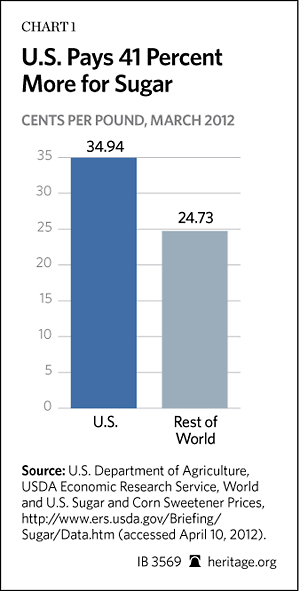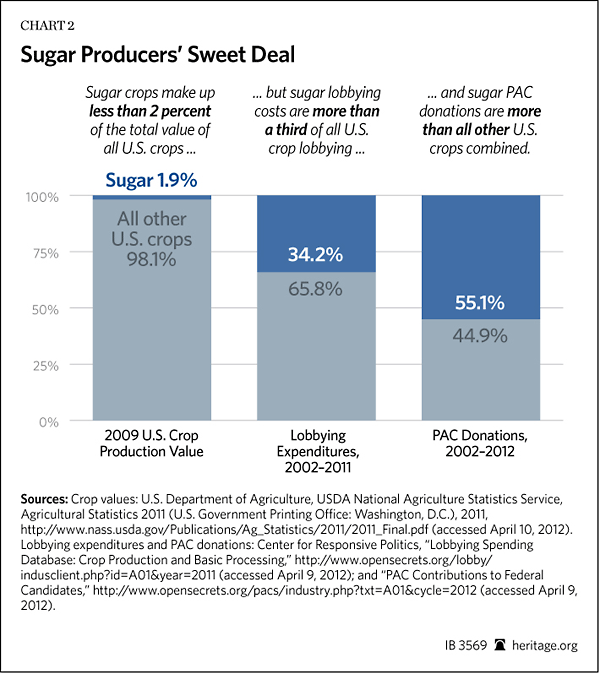Government interference in the sugar market hurts consumers and food manufacturers by driving up the price of sugar, threatening competitive farmers and ranchers by jeopardizing export growth, and weakening the U.S. economy by diverting resources from more competitive uses. This Depression-era program, which was supposed to end in 1940, has outlived its intended lifespan by 72 years.[1] It should be abolished.
How Trade Barriers Increase Sugar Prices
The U.S. government artificially inflates sugar prices by imposing quotas that cap the amount that food manufacturers and consumers in the United States can buy from producers in other countries. If a bakery or a candy company wants to import more sugar than is allowed under the government’s quota, it must pay a prohibitive tariff of 15.36 cents per pound for raw sugar.[2] At current prices, that works out to a whopping 62 percent tariff rate.
Economist Milton Friedman once argued: “There are so many stupid things that government is doing that, clearly, it would be in the self-interest of the public at large to have repealed. Who would—who can really on logical grounds defend sugar quotas? There’s no way of defending sugar quotas.”[3] This has not stopped domestic sugar producers from trying. However, a close examination shows that many of their arguments are misleading. Here are some of those arguments—in their own words—along with the facts.
Falsehood #1: The sugar program is a “no-cost” policy.[4]
Fact: According to the U.S. Department of Agriculture, in March, the price of raw sugar was 40 percent higher in the United States than in the rest of the world.[5] Although the sugar program does not directly transfer funds from the federal government to sugar producers, it cannot accurately be called a “no-cost” program, since it increases prices for everyone who buys sugar or sugar-containing products.

Economist Gordon Tullock explained how sugar tariffs and similar government policies impose additional costs on the U.S. economy:
As a successful theft will stimulate other thieves to greater industry and require greater investment in protective measures, so each successful…creation of a tariff will stimulate greater diversion of resources to attempts to organize further transfers of income.[6]
As long as the government has the ability to hand out favors to some industries and punish others, resources will be diverted away from productive private-sector activities to fund lobbying campaigns in Washington, D.C. This is true for all industries, not just sugar. However, sugar producers have invested heavily in lobbying activities and political donations relative to the size of their industry. Sugar accounts for just 1.9 percent of the value of total U.S. crop production, but sugar producers fund 55 percent of crop-related political action committee (PAC) donations and 34.2 percent of crop-related lobbying expenses.[7] This behavior can result in “crony capitalism”—a system in which business success depends on a close relationship with the government.

Falsehood #2: “Sugar policy didn’t cost taxpayers a dime in ’02, ’03, ’04, ’05, ’06, ’07, ’08, ’09, ’10, ’11 and is expected to run at no cost through 2021.” [8]
Fact: U.S. sugar policy costs taxpayers millions of dimes per year. According to the U.S. International Trade Commission, the sugar program imposes a $49 million net cost on the economy.[9] According to a study commissioned by the Sweetener Users Association, the program costs consumers $2.9 billion to $3.5 billion.[10] According to a study by the American Enterprise Institute, the program costs consumers $2.4 billion per year, with a net economic cost of $1 billion per year.[11]
Sugar policy costs taxpayers by making them pay a little extra every time they buy a box of Lucky Charms, a Honey Bun, a package of Twizzlers, or anything else that contains sugar.
Falsehood #3: “One-sided trade deals force the U.S. to import sugar from 41 countries regardless of our needs.” [12]
Fact: There is not a single person in the United States who is forced to import sugar from other countries. However, more than 313 million Americans are forced to pay inflated prices for sugar.
Sugar industry lobbyists have repeatedly subverted U.S. trade policy and made it more difficult for trade negotiators to expand U.S. export opportunities. For example, during free trade negotiations with Australia, U.S. negotiators allowed Australia to maintain barriers to U.S. exports in exchange for keeping U.S. sugar restrictions in place.[13] Today, the American Sugar Alliance is undermining the Trans-Pacific Partnership (TPP) trade talks by demanding that sugar not be a part of the negotiations.[14]
The sugar industry’s stance is particularly damaging to U.S. farmers and ranchers. U.S. agricultural exports have doubled over the past 10 years, and America’s farmers and livestock producers increasingly rely on foreign markets for their livelihood. Unfortunately, every country has its own version of a sugar lobby working to keep out competitive U.S. agricultural products.[15] If the United States will not open its market to affordable foreign sugar, why should we expect Japan, China, and other lucrative markets to accept affordable U.S. farm exports?
Falsehood #4: “The American sweetener industry has a positive annual impact of $21.1 billion on the U.S. economy, and adds 372,000 direct and indirect jobs in 42 states.” [16]
Fact: According to a 2006 study by the U.S. Department of Commerce, “For each one sugar growing and harvesting job saved through high U.S. sugar prices, nearly three confectionery manufacturing jobs are lost.”[17] In general, trade barriers do not increase employment; they just shift the composition of jobs away from competitive industries toward those favored by the government.
As Adam Smith explained in 1776, removing barriers to imported sugar would have a positive impact on the U.S. economy: “If a foreign country can supply us with a commodity cheaper than we ourselves can make it, better buy it of them with some part of the produce of our own industry, employed in a way in which we have some advantage.”[18]
What to Do About Sugar
According to the American Sugar Alliance, 71 percent of Americans prefer to buy homegrown sugar, even if foreign sugar is cheaper.[19] Consumers deserve the opportunity to prove whether this is true. The government should give Americans that choice by removing caps on sugar imports. Congress is now working on reauthorization of the farm bill, which offers a perfect opportunity to eliminate the sugar program.
Bryan Riley is Jay Van Andel Senior Analyst in Trade Policy in the Center for International Trade and Economics at The Heritage Foundation. Wesley Gwinn and Kyle Niewoehner from The Heritage Foundation's Young Leaders Program provided valuable research assistance.


